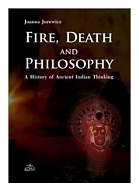Fire Death and Philosophy
A History of Ancient Indian Thinking
This book is an attempt to reconstruct the foundations of Indian philosophy which are
reflected in early Indian texts dated between 13th and 6th B.C.E.
They are religious texts composed in Sanskrit which were transmitted orally in the
families of priests called Brahmins. They constitute the intellectual foundation of Indian
culture called Śruti (śruti), literally, ‘what has been heard’. They are generally
called Veda (veda) which means ‘knowledge’.
The sources forming the basis for the analysis presented in this book come from three
layers of the Vedic tradition. The earliest layer is the four Vedas: the Veda of k-stanzas
(gveda, V), the Veda of Saman-chants (Samaveda, SV), the Veda of Yajus-formulas
(Yajurveda, YV) and the Veda of Atharvans (Atharvaveda, AV).
The first part of this book’s title refers to these three layers of ancient Indian
tradition. The concept of fire is the central metaphysical concept of gvedic thought
and remains such until the Brahmas.
The second part of the title refers to a further aim of the book, which is to present a
history of ancient Indian thought.
Introduction
1. The general aim of the book
2. Cognitive linguistics and semantics
3. The creation of abstract concepts in cognitive semantics
4. The creation of abstract concepts in philosophy using cognitive semantics
5. The content of the book and basic interpretative assumptions
6. An outline of the historical and cultural background
7. Fire and cognition in the gveda
1. The Rgveda
1.1. The blended abstract concepts. Wood, tree and embryo of the waters
1.2. Reality as speech (vac)
1.3. Man is the measure of all things (RV 10.90)
1.4. The Maker of Everything (viśvakarman)
1.5. The search for abstraction (RV 10.72)
1.6. The first philosophical treatise (RV 1.164)
1.7. The Rgvedic concept of fame (śri, śravas, yaśas and ksatra)
1.7.1. Śri
1.7.2. Śravas
1.7.3. Yaśas
1.7.4. Ksatr a
1.7.5. One concept, four words
1.8. Conclusion
2. The Atharvaveda
2.1. Blended concepts with Agni as the input space
2.1.1. Reality as the ruddy one (róhita)
2.1.2. Reality as breath (prana)
2.1.3. Reality as time (kala)
2.2. Conceptualization of reality in terms of man
2.2.1. The concept of the Vedic pupil (brahmacarin)
2.2.2. The concept of Vratya
2.2.3. Man is still the measure of all things
2.2.4. The concept of the pillar (skambha)
2.3. Fire as the essence of reality
2.4. Rgvedic concepts reconsidered
2.5. Experience in philosophy
2.5.1. A stronghold, the wheel of a chariot and a vessel
2.5.1.1. Stronghold
2.5.1.2. Wheel of a chariot
2.5.1.3. Vessel
2.5.2. Lotus, reed and tree
2.5.2.1. Lotus and reed
2.5.2.2. Tree
2.5.3. Wild goose
2.6. Towards abstraction
2.6.1. The concept of the full (purna)
2.6.2. The concept of killing
2.6.3. The concepts of sat and asat
2.6.4. The concepts of atman and brahman
2.6.5. Monism and internal contradictions
2.6.6. The direct cognition of reality
2.7. Conclusion
3. The Satapatha Brahmana
3.1. The creation of the world
3.1.1. Reality is death
3.2. Death in creation
3.2.1. Reality dies through his creatures
3.2.2. Death of reality within its manifest aspect
3.2.3. Reality resurrects in its manifest aspect
3.3. The necessity and significance of death for mortals
3.4. The creation of the immortal part of man.
The verb sam kr-
3.5. The cognitive character of the creative process
3.5.1. Cognition as cleansing and heating
3.5.2. Creation as agreement. The concept of maya
3.5.3. Creation as giving names and assuming forms
3.5.4. Creation as division into truth and untruth
3.6. The concepts of atman, brahman, sat, asat
3.7. Conclusion
4. The Upanisads
4.1. Cosmogony
4.1.1. The continuity of tradition (Brhadaranyaka Upanisad 1.2)
4.1.2. The redefinition of the concept of atman (Brhadaranyaka Upanisad 1.4)
4.1.3. Reality and manifestations of atman in the Aitareya Upanisad
4.1.4. The levels of experience (Chandogya Upanisad 6.1-7)
4.1.5. Reality really transforms itself. Sat, tyam and satyasya satyam
4.2. Ontology
4.2.1. The cognitive relationship between aspects of reality
4.2.2. Ways of description of reality
4.3. The role of man
4.3.1. Men create reality. The model of the Five Fires and the two afterlife paths
4.3.2. How to achieve the path of gods (Chandogya Upanisad 4.10-15)
4.4. Liberating cognition
4.4.1. The state gained in liberating cognition
4.4.2. The nature of liberating cognition and its stages
4.4.2.1. Tradition reworked (Chandogya Upanisad 3.1-14 and Satapatha Brahmana 10.6.3)
4.4.2.2. How the unmanifest can be seen (Brhadaranyaka Upanisad 2.1-3)
4.4.2.3. Who sleeps and who does not (Brhadaranyaka Upanisad 4.3-4)
4.4.2.4. Philosophy in practice (Chandogya Upanisad 8.1-12)
4.4.2.5. Abstraction of experience (Taittiriya Upanisad 2.1-5)
4.5. Conclusion
5. Afterlife and the belief in rebirth
5.1. Accounts of the Jaiminiya Brahmana (1.17-18, 1.45-50)
5.1.1. The model of the Five Fires in the Jaiminiya Brahmana and the first afterlife path
5.1.2. The second afterlife path
5.2. Account of the Jaiminiyopanisad Brahmana (3.7-28)
5.2.1. The first afterlife path
5.2.2. The second afterlife path
5.2.3. The third afterlife path
5.3. The afterlife paths according to the Kausitaki Upanisad 1
5.4. Conclusion
General conclusion
1. The way the abstract concepts are built
2. The development of early Vedic philosophy
3. The early breath practice connected with recitation
4. Other topics for further research
Bibliography
Indeks (English, Latin, Greek)
Index (Sanskrit)
Index (fragments discussed in the book)
716 pages, Paperback


